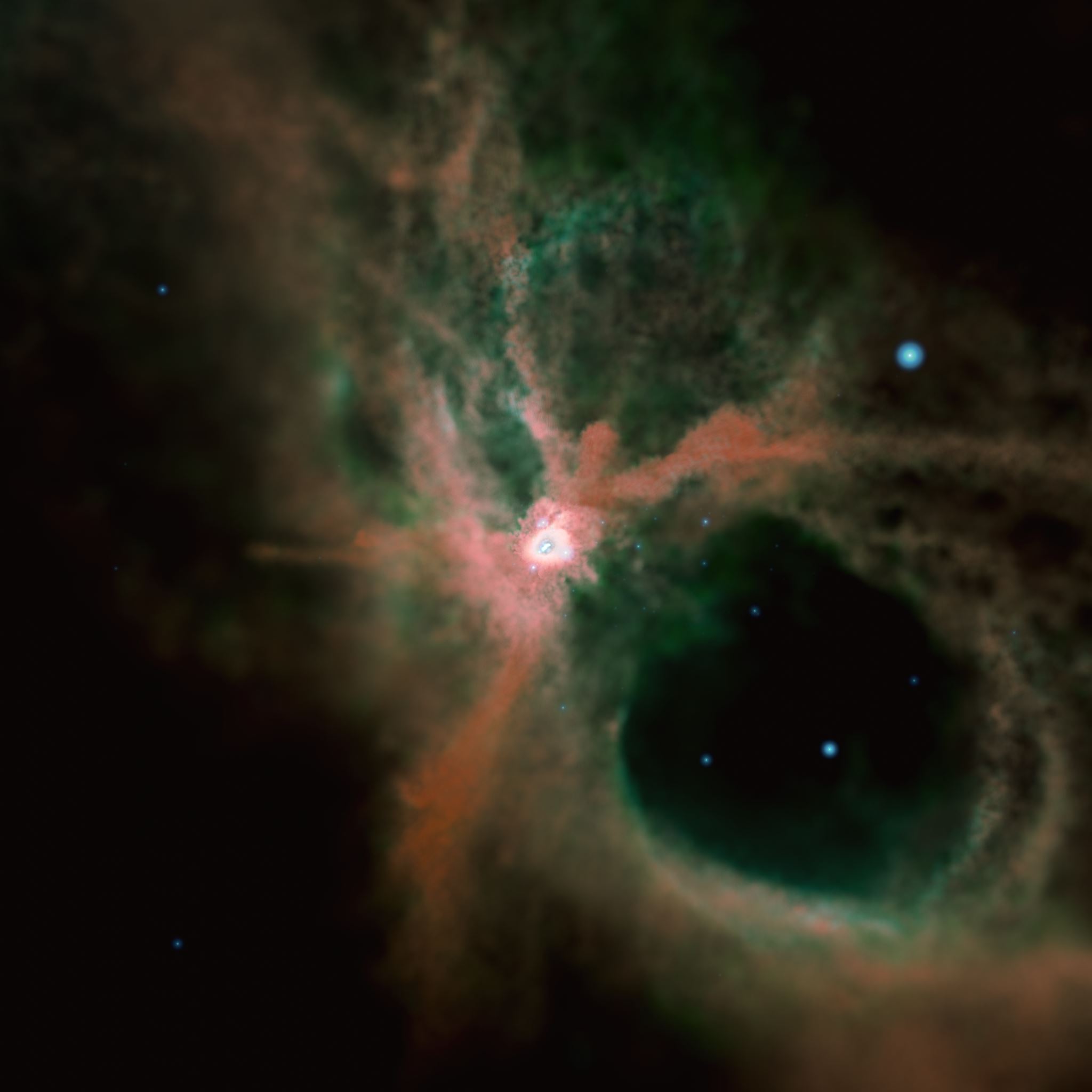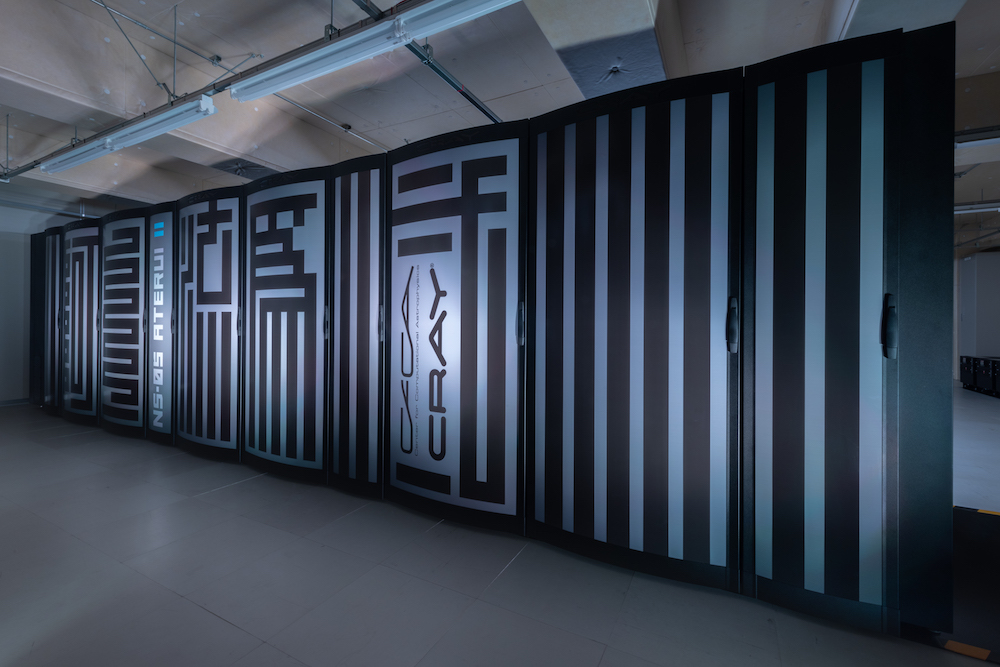A research group at the University of Tokyo has performed a simulation of star cluster formation using a newly developed simulation code. The simulation revealed that some massive stars formed in the star cluster center were ejected to the outskirts of the cluster and ionized the molecular cloud there. These processes caused the formation of off-centered ionized bubbles seen in the Orion Nebula.
In the simulation, the motions of stars in molecular clouds were accurately solved. The importance of the motions of massive stars in the formation phase of star clusters was for the first time shown using the new simulation. The simulation will be upgraded to simulations for up to 100 times more massive star clusters to understand the formation process of massive stars and star clusters.
Stars are born in molecular clouds, which are dense and cold molecular hydrogen gas. When many stars are formed in a small region, the stars are gravitationally bound to each other and develop a star cluster. Star clusters usually contain massive stars, which are more than eight times more massive than the sun and rarely form. Massive stars finally ionize the molecular gas and terminate the star cluster formation. The Orion Nebula Cluster, a massive star cluster located in the Orion Nebula, is a star cluster that is currently in the formation stage.
The Orion Nebula is associated with an ionized bubble, which is a high-temperature region filled with hydrogen ionized by massive stars. The most massive star in this region, theta 1 Orionis C, is located in the Orion Nebula Cluster, but this star does not center the ionized bubble in the Orion Nebula. In order to form such an off-centered bubble, ionizing photons emitted from the massive star in the cluster center must reach the outskirt of the cluster overwhelming the dense molecular gas in the cluster center. The simulations showed that 1. massive stars were formed in the central region of star clusters, 2. massive stars were scattered by their gravitational interactions, and 3. the scattered massive stars made a hole in the dense molecular gas in the central region and helped the formation of off-centered ionized bubbles. The kinematic data of stars around the Orion Nebula Cluster suggests that some massive stars are ejected from the cluster center and that theta 2 Orionis A, which is the second massive star in this region, is now going back to the cluster center.
In this study, the research group performed a state-of-the-art simulation of star cluster formation, in which the motions of individual stars were accurately reproduced. With this code, the scattering process of massive stars during the formation phase of relatively massive star clusters was, for the first time, simulated. The simulations were performed using the supercomputer ATERUI II at the National Astronomical Observatory of Japan.
“Most previous studies have focused on the hydrodynamical aspects of the formation of star clusters. However, we are more interested in the dynamics of star clusters, such as the scattering of stars and the initial density of star clusters. The initial density of star clusters is an important factor in determining the following evolution of star clusters. A high density of star clusters results in the runaway merger of stars and the formation of massive black holes, which we have not fully understood the formation process. Therefore we aim to reproduce individual stars and their accurate motions in our simulations.” Michiko Fujii explained.
“Our team took more than two years to develop the new code. Four main contributors worked together to combine their codes. We got very excited when we found a simulation that looked similar to the Orion Nebula, and we got excited again when we confirmed that the velocity distribution of stars in our simulations matches the observation.” she said.
“The simulation is part of the SImulations Resolving IndividUal Stars (SIRIUS) project. This project aims to perform novel simulations of star clusters and galaxies, resolving the dynamics of individual stars. This simulation is not the limit of our simulation code. If we use a larger number of CPUs, it can treat even more massive star clusters. We will challenge the first star-by-star star-cluster formation simulation of globular clusters, which are 100 times more massive than the star cluster we simulated in this study.” Fujii continued.
Download: [mp4, 41 MB]
These results appeared as Fujii et al. “SIRIUS Project. V. Formation of off-center ionized bubbles associated with Orion Nebula Cluster” in Monthly Notices of the Royal Astronomical Society on June, 8, 2022.
[Research Paper]
Title: SIRIUS Project. V. Formation of off-center ionized bubbles associated with Orion Nebula Cluster
Authors: Michiko S. Fujii, Kohei Hattori, Long Wang, Yutaka Hirai, Jun Kumamoto, Yoshito Shimajiri, Takayuki R. Saitoh
Journal: Monthly Notices of the Royal Astronomical Society
DOI: 10.1093/mnras/stac808
[Supercomputer used in this research]
[About this research project]
Project Website: SIRIUS Project
This research was supported by MEXT/JSPS KAKENHI Grant Number 19H01933, 21K03614, 20K14532, 21J00153, 21K03633, 21H04499, MEXT via the“Program for Promoting Researches on the Supercomputer Fugaku” (Toward a unified view of the universe: from large scale structures to planets), and JICFuS.
[For the Use of Contents in This Website]
- Contents are to be used with a clear indication of its copyright (e.g. (c) NAOJ.)
- If you would like to use the contents found in this web site, please follow Terms of Use of the Website of NAOJ.
[Related Links]
- Project Website: SIRIUS Project
- The University of Tokyo Press Release: Massive Stars Moving around in Star Clusters
- NAOJ Press Release: Yoyo Stars Responsible for Off-Center Bubbles


